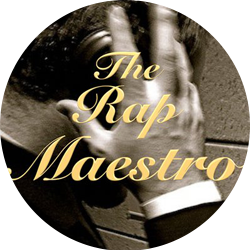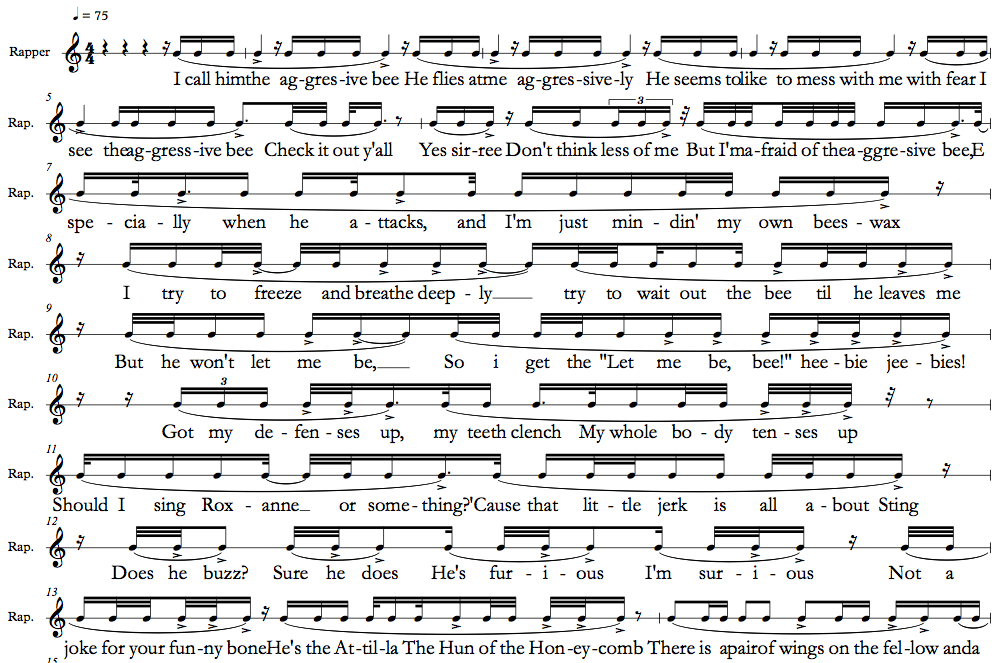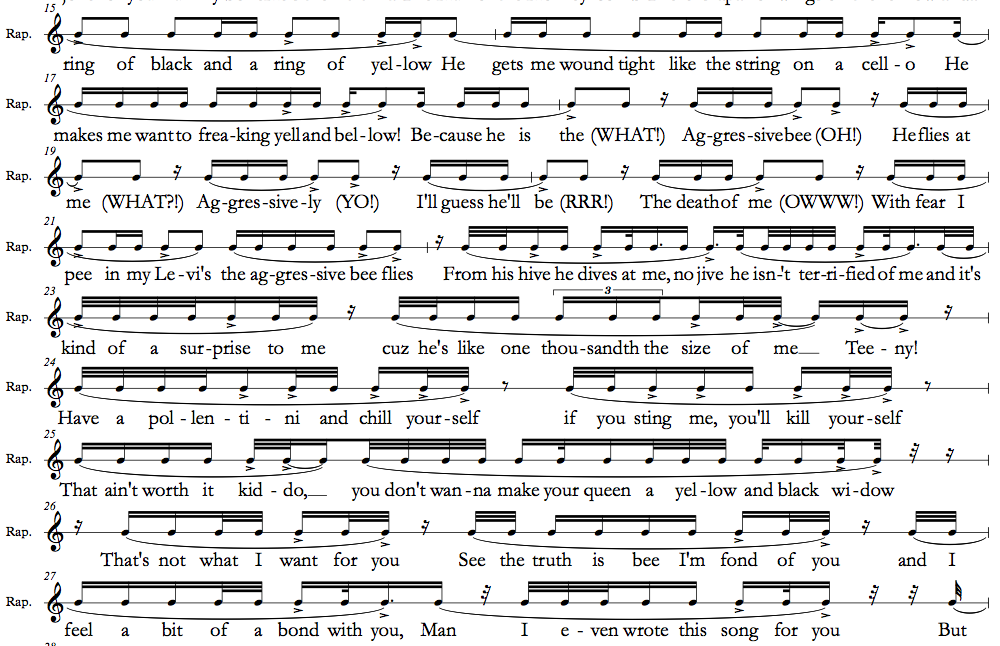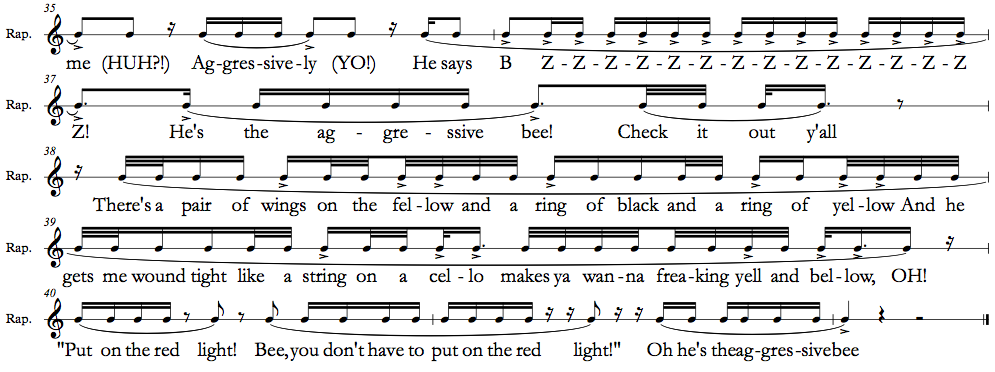This will be a rap music analysis of MC Mr. Napkin’s hit Youtube Video, “Aggressive Bee.” We will use some of the techniques used earlier on previous rap analyses that I’ve done on my blog, “The Composer’s Corner”, such as when looking at raps by Eminem or Nas. This time, however, will be a first-time foray into new, uncharted territories for my analysis: we will now be looking at what I will from here on out call “comedy rap.”
Now, I must say when the host of this show, Mike Blejer, first approached me with this opportunity to look at an explicity comedic rap, I was kind of licking my chops. You know what they say about musical comedy: it’s made by people who aren’t good enough at either to do them alone! However, in short, I was pleasantly surprised to find that MC Napkins’ video holds up to critical as well as popular (He has 380,000+ hits) scrutiny.
First, it is important to make some distinctions. I have termed MC Mr. Napkins’ work, and others like his, comedy or comedic rap. This is because they’re lyrical content is dominated by jokes and puns. Most importantly, however, the work of comedic rappers will often play upon the very conventions of rap itself, as MC Mr. Napkins’ work in “Aggressive Bee” certainly does. However, there is to be a disclaimer: comedy, that is, humor in a more general sense, has ALWAYS been, and even is today, part of rap, even back to its most earliest form when it was simply a chant-style at parties to get the crowd going. We can see this in some of the earliest hit songs from the genre, including Sugar Hill Gang’s “Rapper Delight” (which you can hear below),
where an MC mocks the story of Superman and his whole get-up. Then, we see it up to even today: in Kanye West’s recent hit, “Niggas in Paris”,
we see Kanye making fun of the girls he attracts in the 2nd verse. He quotes, “Dat shit cray…Ain’t it Jay? / what she order?…fish filet?” However, comedic rappers differentiate themselves largely by filling their lyrical content completely with humor, and by playing upon the conventions of rap, as we shall see.
This distinction made, we can now see in what ways MC Mr. Napkins fits our 2 broad criteria for inclusion in a comedic rappers context. (Note: at times it may seem pedantic to point out why a certain lyric or rhyme is funny, but it is necessary as it will all build to our ultimate conclusion at the end.) Certainly, the song is dominated completely by humor: the entire song is about a bee that bothers the rapper when he’s trying to write his rhymes. This is essentially connected to what the overall joke is of the song, however: the rapper is going completely crazy, as many rappers are apt to do (such as in Eminem’s “Kim”
from the Marshall Mathers LP – seriously, don’t listen to it if you can’t stomach gratuity), but he does it over…a bee bothering him! The gist is then that the rapper, MC Mr. Napkins, is rapping hardcore about a rather benign subject. Let’s take a look at what specific ways Napkins lampoons the conventions of the genre to create his intended humorous effect.
It is worth mentioning, however, that this popular stereotyping of rap music certainly does not hold for the entire genre. Today, rap is known for violence, misogyny, drugs, guns, and so on. But this was not always the case. Rap really only become gangster-ized in the mainstream in the early 90s, with the rise of G-funk from the West Coast through Dr. Dre and NWA. In fact, rap had something of an identity crisis over this fact; one need only observe the lyrics and metaphor inherent in Common’s “I Used To Love H.E.R. (Hearing Every Rhyme”, which is analyzed here.) We can see this from other examples throughout the genre. Standing out in particular is The Roots’ “Lazy Afternoon”, from their 1995 LP, “Do You Want More?!!!??!”. It is all about…Black Thought’s afternoon one time. It simply should be known that a classic stereotype of rap does not hold true.
But first, MC Mr. Napkins begins by playing his cards close to the chest, he begins his rap with a simple cadence. This is a 2 beat phrase, quoted below,
that is repeated 7 times, to fill out a full 4 bars. This makes fun of the sometimes too repetitive nature of rap music, such as OFWGKTA’s (or simply known as “Odd Future”) “Swag Me Out”, where the hook is simply a 2 beat idea, “Swag me out, bitch” repeated 16 times (it should be noted, though, that I actually really like that song). Hear it here:
This completely fulfills the “tyranny of 4” that was discussed on my blog. (The basic gist is this: much popular music suffers from fitting into bar structures and phrases that are divisible by or divisible into 4, such as 2, 4, 8, 16, or so on.) His cadence here reminds me of Wiz Khalifa’s start to his first verse on “Black and Yellow” – “Black stripe…Yellow paint…”
The joke here is, of course, that he’s rapping intently about a bee. Now, at this point in time when hearing it, I was like “okay, here we go…another comedy rapper, doing the same thing…” No one can deny that rap, as seriously as most of it takes itself, opens itself up to a lot of humorous criticism. But many people do it, and it gets boring. I’m sure you’ve heard your friends “freestyle”, saying “Yo yo yo, I’m gonna go, to the sto’”, or whatever. But to do it skillfully is another game completely. Because if Napkins had continued to repeat those phrases, it would have been rather boring. But he doesn’t! He actually goes on to make a rather technically gifted rap that fits well in an innovative form! And here is the most subversive, funniest thing Napkins could have done, which he did: parody rap…while making an excellent rap song. So shall we see.
At bar 5, Napkins opens with a 12-bar verse. This is the first verse in a loose Chorus – Verse – Chorus – Verse – Chorus – Outro form, where each chorus is slightly differentiated from the others, and the outro is a loose fitting together of various previous material. It is time to describe Napkins’ flow. A rapper’s “flow” is the musical description of his rap. It is a combination of where he places poetic accents in the bar, how quickly he raps, how he articulates his rap, whether he uses phrases, and so on. A poetic accent is created when a rapper rhymes two or more words together. That is, I believe rhymed words in a rap stand out in the listener’s ear, and that these are essential for how the ear hears a rap. With this basic analytical information in hand, we can no set out to try and describe Napkins’ flow.
In short, it’s sick. Throughout the entire time I was writing down his rap in music, I kept thinking to myself “Wow…if you take these rhythms, and change the words to talk about drugs or gangbanging, up the production a little and throw it on the radio, you’ve got a top 40 hit!” Some more basic musical background info is necessary. This song is in 4/4. This means that there are 4 quarter notes per bar, and that the quarter note gets the bar. If you tap your hand evenly to the bass drum kick (low sound) and snare drum (high sound), you’ll be counting the beats. The song is at a tempo rate of quarter note = 75 BPM (beats per minute). This means that a quarter note, the basic beat, appears 75 times in a minute. This leaves the music in an interesting no-man’s land: it is not quite as quick as most rap, which I would say is around 90-110 BPM. But it’s not slow enough to be double time, which is when the snare sound appears on the 3rd beat rather than the 2nd beat, giving the music the appearance of beaing twice as slow (hence the term, “double time.”) (Usually, in a bar of 4/4 – remember, 4 quarter notes – the bass kicks land on beats 1 and 3, and the snare lands on beats 2 and 4.) Being this slow opens up the rhythmic spectrum for Napkins to play on.
From surveying the transcription, one can see that Napkins makes use of many different rhythmic durations. You can see quarter notes, 8th notes, 16th notes, and even 32nd notes! Rapping at a level of 32nd notes means that there are 8 subdivisions of the beat to a single beat. Again, this is able to be done because of the slow tempo of the song. A 32nd note is the level at which Napkins is rapping when you see the triple bars over a note, such as on the words “Check it” in bar 5. This is also the metric level he begins rapping at when he starts his verse in bar 6. Here, the humorous impact of the entire song’s premise is increased even further. Note only is he rapping about a bee, he is really going in on that sh*t. He’s not just lackadaisically talking about some bee that was bothering him, he’s pissed or mad or whatever at that bee, and is rapping really fast about it. First, to rap at this rhythmic level is very intense, and not done by many rappers. It takes quite some skill. The only rappers I can think of with comparable flows would be Twista (example: his verse from Kanye’s “Slow Jamz” off his College Dropout Album, seen here
or Bone Thugs N Harmony (example: “Thuggish Ruggish”,
I wonder if Napkins is familiar with either of their work. Anyway, in the upcoming analysis we shall see how Napkins varies the basic metric level (32nd note, 16th note, 8th note, etc.) at which he raps to differentiate structural sections from each other.
As discussed earlier, rappers create accents by rhyming words together. These are marked in my transcription by the little greater than sign under notes, such as on the “-ree” of “Sir-ree” in bar 6. Thus, we see accents on –ree, me, and bee in that bar. The rate at which accents come, as well as where they fall in the bar, are, I believe, essential in defining a rapper’s flow. Thus, we can see that Napkins’ begins his verse with 3 accents in one bar. Throughout this entire rap, in fact, Napkins’ flow is accent heavy. (This means, basically, that there are lots of rhymes.) This is also something skillful to be able to pull off. That is why I was so blown away by his flow: he masked really good rapping skills in a song parodying the genre! Stereotypically, accents will come only once in a bar, at the end of each one, as one can observe from the opening 4 bars of Kanye’s “Niggas in Paris” quoted earlier. However, Napkins has upped the ante technically. We see this continue in bar 8: “freeze”, “breathe”, “deep”, “-ly”, “bee”, “leaves,” and “me.” That’s 7 accents in one bar! In comparing this to previous rappers I’ve analyzed on my blog (The Game, 50 Cent, Nas, Eminem, Jean Grae, Common, Time Bomb), only Jean Grae, Eminem, and Nas come close to this level of accent (DISCLAIMER: these rappers were not always trying to fill up their bars with accents, and Napkins is rapping twice as fast…it’s just for comparison, okay???) Then, in bar 9, he lets loose what is probably the best rhyme of the song: “Let ME BE, BEE HEE-BIE JEE-BIES!” (Rhymed words accented there.) Now, that’s just a sick rhyme to be able to pull off. 7 straight accents? Again, only Jean Grae topped that (you can check out the analysis of her style here. So as we can see, Napkins has some chops.
So, he’s been rapping really intensely about a bee, but Napkins also goes on to make fun of the genre in other ways. For instance, in bar 12, he raps “Does he buzz? / Sure he does… / He’s furious… / I’m SUR-i-ous.” Note that he says SUR-i-ous, and not SER-i-ous. This is making fun of the Dirty South’s way of pronouncing things, really made famous in the mainstream by Chingy’s “Right Thurr”
He says he likes it when girls do it right there, but he actually says “thurr” for “there.” This is lampooned most famously by Kanye West in his “All Falls Down”, when he raps “Sophmurr, three yurrs, ain’t picked a carurrr” (“Sophomore, three years, ain’t picked a career” – hear it here, http://www.youtube.com/watch?feature=player_detailpage&v=0jOODy6en-Y#t=29s) Napkins’ rhyme here is reminiscent of a technique Kanye uses all the time: changing the pronunciation of words to make them rhyme. I would say this is a defining characteristic of Kanye’s flow. Most blatantly, he raps on a song “Spanish girls saying No habla ingle / And everybody wanna run to me for they singlay.” Hear it here, Kanye’s is the 2nd verse:
Here, No Habla Englais = I don’t speak Spanish, and “singlay” is supposed to be the word “single.” Napkins does the same thing when he changes the pronunciation of “serious” to “surious”, because it wouldn’t have rhymed otherwise.
Then, 8 bars in, at a very important structural part of the song, Napkins varies his flow. He now begins rhyming at the 16th note level, rather than the 32nd note level, which he had been doing up until then. The amount of relief this new idea brings to the ear is excellent. As discussed before with the “tyranny of 4”, it is an excellent place to vary the flow with a new idea. Plus, it’s a good segue into the chorus, and is actually an idea which will return in a rather musically complex move later.
And so, beginning at bar 18, we get a 4 bar chorus, similar to the 4 bars that opened the song. This time, however, there are some backgrounds “Oh’s!” and “Yo’s!” thrown in for good measure. This, of course, is making fun of the tendency of rappers to throw in background exclamations in their rap. This can be seen pretty clearly in Lil Wayne’s “Go DJ”, with all the “Yeah’s” in the background (heard below,)
and the general sing-song, back-and-forth nature of the hook (“Go DJ!…that’s my DJ…”) and so on. Or, in Lil Wayne’s “Hit Em Up”, when he provides background effects for his 3rd verse. (Hit Em Up, skip to 2:51:
Napkins’ making fun of rap conventions continues! He has in the chorus returned to the same 2 beat phrase that opened the song.
After this second chorus, Napkins spits another verse, this time 8 bars long. He returns back to the 32nd note level. This change in metric level differentiates the chorus clearly from the verse. Much of what was said about the 1st verse can be said about this 2nd verse, such as the rate of accents. It might be important here, though, to draw attention to how Napkins structures his phrases. The phrases are delineated by those long lines connected different notes together underneath the notes, almost like notes, such as from “cuz” to “me” in bar 23. The only thing to say here is that Napkins avoids monotony by varying how long each phrase, and where it appears. Also, note that Napkins, throughout both verses, is always varying where the accent (again, rhymed words) fall in the bar. They never are in the same metric position from one bar to the next. This shows us that his flow, apart from the choruses, are not reliant on phrases, as other rappers’ are (See my analysis of Eminem’s “Business” for an example of phrase-heavy rap, here.) Although completely an aesthetic call, I prefer rappers that do this. Again, in comparison with before, Nas is someone who does this as well (you can see analysis of Nas’ phrases here, here.) Then, at bar 30, we get to a kind of dance-song rhythm for 4 bars, where Napkins repeats “The bee’s aggressive.” We then get to the 3rd chorus, which again is slightly differentiated from the other 2, this time by his adding “B-Z-Z-Z-Z-Z-Z-Z-Z-Z-Z-Z-Z-Z-Z-Z!” at the end. This again avoids any monotony that might cloud the ear, as many “real” rap songs do, as quoted earlier.
At bars 38 and 39, however, we reach a very interesting moment musically. These are the lyrics from “There’s a pair of wings” to “freaking yellow and bellow, oh!” Now, this material has already appeared in the song, in bars 14 to 17. This time, however, instead of having the same lyrics take up 4 bars, they take up 2 bars. This musical technique is known as diminution. That is, the music-maker (here, Napkins) cuts the rhythmic duration of each note in a musical idea in half. This is a really very classical musical technique. Many classical composers do this, such as Bach. This example from wikipedia quotes Contrapuntus VII from Bach’s Art of Fugue, which has the canon subject in diminution in the bass voice. To do this in a rap song is really interesting, and unprecedented in my mind (I can’t think of any other rap songs that have done this.) This is done for an emotional effect, of course, as the faster rhythms drives home the point of how much this bee annoys Napkins.
In bars 40 and 41, then, Napkins quotes the song “Roxanne”, which he alluded to earlier. The tradition of rapping allusions into lyrics can be found literally in any rap song ever, and so specific quotes of songs here aren’t needed. But the irony here of corse is in Napkins quoting a band like “Sting” in a song that purports to be hardcore, leading to a very humorous juxtaposition. And then, he ends with the 2-beat phrase that has anchored his choruses: “He’s the aggressive bee.”
One can see from all this analysis, then, that Napkins has done the most original, funny, subversive thing he could’ve: he’s made a rap song that makes fun of itself, while actually being of very high quality. He alludes to many of the clichés of rap music, such as mispronounced words (“Surious”), background voice effects and yells (The chorus’s “OH!” and “YO!”), and allusions (“Put on the red light!”). But all of them are couched within a song that avoids the general tyranny of 4 by slightly differentiating each verse and chorus section from each other, and a rap that is actually pretty technically complex.
No wonder he’s got 380,000+ views. Moving forward, I’d be very interested to know who his musical influences were, especially rap. I’d also like to see some other works of his. Below is the entire transcription of MC Mr. Napkins “The Aggressive Bee.” Hope you enjoyed this rap music analysis!







Oh my God. Knowledge has officially been dropped and mind blown.
This post is really incredible, one of the most helpful I have ever read, indeed. Rap Music Online
This is interesting! I enjoyed reading your great post.Thanks for the valuable information and insights you have shared here.Free Mp3 Download
Thank you! I appreciate the compliment!